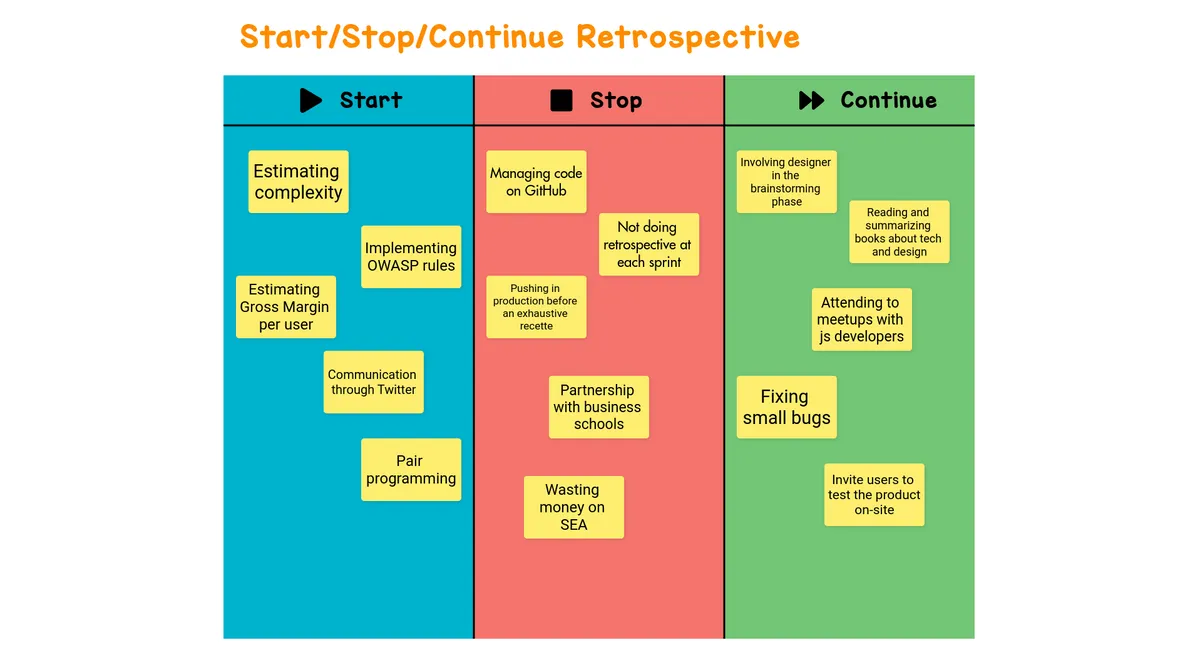What is the Start-Stop-Continue Retrospective?
The Start-Stop-Continue Retrospective is a simple yet effective ceremony format used by Agile teams to identify actions to implement as part of the continuous improvement process. It’s an ideal format to run with your team at the end of a sprint!
This retrospective invites participants to organise their ideas across three categories:
- Start: What should an individual participant or team do (or test) to either improve their own processes and practices or boost end-user satisfaction?
- Stop: What should an individual participant or team stop doing because it either hurts their ability to do work effectively or doesn't provide enough value to end-users?
- Continue: What should an individual participant or team keep doing until it either becomes a habit or can drive learnings for future improvements?
How to run a Start-Stop-Continue Retrospective ?
The Start-Stop-Continue Retrospective takes place in 4 steps:
Step 1: Individual reflection
The facilitator should give participants five to ten minutes to jot down ideas on sticky notes for each of the three categories above. Each sticky note should represent only one idea.
Be sure to use “polling booth mode” to ensure participants don’t inadvertently influence each other with their ideas before it’s time to share. As a best practice, assign each category a different sticky note color to keep things organized visually.
Step 2: Commenting and reorganizing ideas
Once the time cap has been reached, participants can take turns sharing their ideas with the rest of the team. The role of the facilitator here is critical to ensure that the overall atmosphere remains positive and constructive. It’s important to remember that this should not become a “blaming” session but rather an opportunity to identify areas of improvement.
Step 3: Proposal of areas for improvement
Following the discussion in Step 2, the facilitator gives participants another five to ten minutes to come up with ideas for improvement and write them down on sticky notes. Once all ideas have been submitted, the facilitator should take a moment to group together similar ideas before sharing them with the team and then putting them up for a vote.
Step 4: Selection of areas for improvement
Finally, the facilitator gives each participant an opportunity to vote for the three areas of improvement to be implemented during the next sprint. The three sticky notes with the most votes will be deemed the “winners” of this exercise and put into action immediately.
Tips and advice from an Agile Coach
Naya Luceau, Agile Coach and Scrum Master, has led many Start-Stop-Continue Retrospectives with Agile teams. Here are her tips for getting the most out of them:
- Add initials to the sticky notes to make knowing who submitted each idea clearer.
- To keep things organized when moving sticky notes around, be sure to identify a set color for each category (i.e., Start = blue, Continue = green, Stop = red).
- Avoid the temptation to add too much detail to the sticky notes; the goal here is to open up a discussion with the team.
- Set a maximum number of sticky notes that each participant can submit to the brainstorm, along with clear rules of engagement. For example, you could say something like: “You only have three sticky notes each. Distribute them as you wish, whether that means putting 1 in Stop, 2 in Continue, or all 3 in the same category.”
Suggested resources for learning more about the Start-Stop-Continue Retrospective
- A detailed article by media Geekflare: Start Stop Continue Retrospective Explained [With Template Resources].
